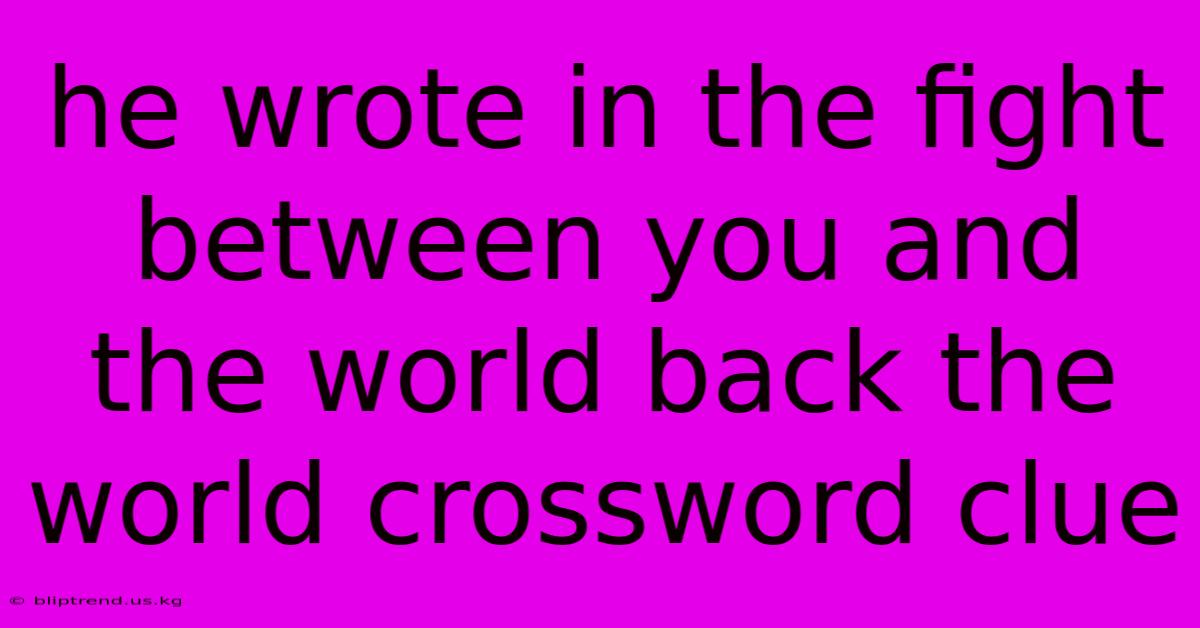He Wrote In The Fight Between You And The World Back The World Crossword Clue

Discover more in-depth information on our site. Click the link below to dive deeper: Visit the Best Website meltwatermedia.ca. Make sure you don’t miss it!
Table of Contents
Decoding the Crossword Clue: "He Wrote in the Fight Between You and the World Back the World"
This crossword clue, "He Wrote in the Fight Between You and the World Back the World," is a cryptic one, demanding more than a simple knowledge of authors. It requires an understanding of literary context and a bit of lateral thinking. Let's break it down to reveal the answer: Ernest Hemingway.
Understanding the Clue's Structure
The clue is a complex sentence cleverly disguised as a straightforward question. Let's dissect each part:
- "He Wrote": This indicates the answer is the name of a male author.
- "in the Fight Between You and the World": This refers to a central theme found in much of Hemingway's work – the internal and external struggles of individuals against overwhelming odds, often represented by a harsh and unforgiving world. This is a key thematic element that links to his style and life experiences.
- "Back the World": This part is the most cryptic. It suggests that the author's writing somehow "pushed back" against, or challenged, the negative aspects of the world he depicted. This alludes to Hemingway's powerful and often defiant prose style, which directly confronts difficult realities without sentimentality.
Why Ernest Hemingway?
Several aspects of Hemingway's life and work perfectly align with the clue:
-
Thematic Resonance: Hemingway's novels and short stories frequently explore the "fight between you and the world." Characters in his works, often veterans or individuals facing existential crises, grapple with disillusionment, loss, and the brutal realities of war and life. Think of The Sun Also Rises, A Farewell to Arms, For Whom the Bell Tolls, and The Old Man and the Sea. These narratives showcase individuals battling internal demons and external pressures, reflecting the clue's "fight" imagery.
-
Style and Defiance: Hemingway's distinctive minimalist style, characterized by concise sentences, direct language, and a focus on action and imagery, served to directly confront the harsh realities he depicted. His writing wasn't flowery or evasive; it was a forceful, almost visceral representation of the world, a direct "push back" against the indifference and cruelty he saw. His unflinching portrayal of war, death, and human suffering challenges readers to confront uncomfortable truths, demonstrating the "Back the World" aspect of the clue.
-
Biographical Parallels: Hemingway's own life mirrored the struggle described in the clue. He witnessed firsthand the horrors of war, battled personal demons, and ultimately ended his life in a tragic confrontation with his own internal struggles. His life, both the triumphs and tragedies, embody the spirit of the "fight between you and the world." His enduring legacy demonstrates his work's ability to withstand the test of time, further reinforcing the idea of "backing the world" through powerful storytelling.
Exploring Hemingway's Thematic Consistency
To further solidify Hemingway as the answer, let's delve deeper into the consistent themes found throughout his oeuvre:
-
Man vs. Nature: Many of Hemingway's works pit individuals against the unforgiving forces of nature, whether it's the relentless sea in The Old Man and the Sea or the harsh landscapes of war. This constant struggle against overwhelming odds resonates with the clue's "fight between you and the world" theme.
-
Loss and Trauma: The impact of war and loss are recurring themes, particularly in A Farewell to Arms and The Sun Also Rises. The characters' struggles with grief, disillusionment, and the psychological scars of trauma directly reflect the inner battles implied in the clue.
-
Masculinity and Stoicism: Hemingway's male protagonists often embody a stoic masculinity, enduring hardship and suffering without outwardly displaying emotion. This stoicism can be seen as a form of resistance against the world's harshness, a further manifestation of "backing the world" through strength and resilience.
-
Existentialism: Underlying many of his narratives is an exploration of existential themes, questioning the meaning of life in the face of suffering and mortality. This philosophical undercurrent adds depth to the “fight” and makes Hemingway's characters relatable even today.
Beyond the Literal: The Cryptic Nature of the Clue
The beauty of this crossword clue lies in its ability to go beyond a simple factual identification of the author. It demands an understanding of Hemingway's thematic concerns, his writing style, and even biographical elements. The clue acts as a literary puzzle, testing not just knowledge but also the ability to synthesize information and interpret hidden meanings.
Conclusion
The answer, Ernest Hemingway, is not merely a name; it’s a multifaceted response to a cleverly crafted clue. The clue itself serves as a mini-literary critique, highlighting the central themes and stylistic choices that define Hemingway's enduring legacy. The more deeply one understands his work, the more clearly the answer emerges. This exemplifies the intellectual challenge and satisfying revelation that make cryptic crosswords so engaging. The clue’s success lies in its ability to provoke thought and reward careful consideration, not just a simple recall of facts.

Thank you for taking the time to explore our website He Wrote In The Fight Between You And The World Back The World Crossword Clue. We hope you find the information useful. Feel free to contact us for any questions, and don’t forget to bookmark us for future visits!
We truly appreciate your visit to explore more about He Wrote In The Fight Between You And The World Back The World Crossword Clue. Let us know if you need further assistance. Be sure to bookmark this site and visit us again soon!
Featured Posts
-
Summertime Setting Abbr Crossword Clue
Jan 10, 2025
-
With 13 Down Herbal Brew Crossword Clue
Jan 10, 2025
-
Fisa Warrant Objective Crossword Clue
Jan 10, 2025
-
Place For Baby Birds Crossword Clue
Jan 10, 2025
-
Nyt Crossword Answers 04 04 18
Jan 10, 2025
